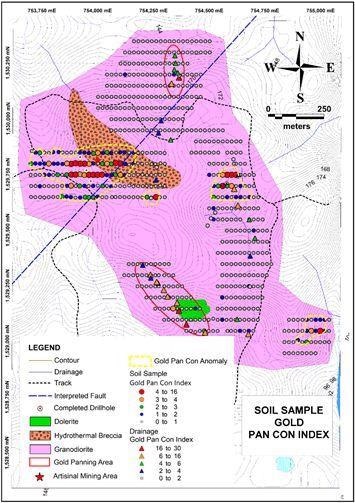Dec 3 2020
Stephen Burega, the Chief Executive Officer of Angkor Resources Corp., reports that the company has recently concluded a mapping and sampling program on its fully owned Andong Meas property.
 The above map shows the recent sampling program locations, new gold anomalies, and pancon index results. Image Credit: Angkor Resources Corp.
The above map shows the recent sampling program locations, new gold anomalies, and pancon index results. Image Credit: Angkor Resources Corp.
Highlights
- Angkor Resources’ team has identified four new epithermal anomalous gold targets around the external border of the earlier identified Canada Wall (CW) copper porphyry target
- The anomalies seem to be analogous to other structurally regulated epithermal gold occurrences found on the Oyadao North and Andong Meas licenses
Angkor Resources’ team performed a comprehensive soil sampling program that revealed a pair of new gold anomalous targets to the southeast and east of the main anomalous region located at the CW prospect on the Andong Meas license. CW is essentially a copper-molybdenum porphyry occurrence that has many gold anomalies around it.
This is very similar to what we have seen at other identified gold anomalies at Oyadao North license, and elsewhere on the Andong Meas license. These anomalies are structurally controlled epithermal gold occurrences. The benefit of this type of structure is typically their proximity to surface with possible high-grade ore shoots. These new areas will be examined immediately to determine the best methods of evaluating them to a drill-ready stage.
Dennis Ouellette, Vice President of Exploration, Angkor Resources Corp.
“Artisanal miners on the Canada Wall property were recovering gold from creeks during this past rainy season. The Company sent out a crew to pan along two creeks not previously sampled to test for gold. In addition, the banks of five creeks were soil sampled to determine if the source of the gold could be discovered and we have high expectations that we have in fact identified additional significant gold targets,” stated Burega.
Additional gold and multi-element assay results from the soil sampling program are still pending.
Previous Exploration
The Andong Meas License hosts Angkor Resources’ CW copper-molybdenum gold porphyry system, the neighboring South Creek copper porphyry system prospect, and also a number of gold targets. These gold targets include the Wild Monkey that showed numerous surface samples with gold grade up to 3.93 gpt, and the Wild Boar that has seen widespread artisanal mining in the past and exhibited numerous surface samples with gold grade up to 70.7 gpt.
Angkor Resources designed exploration programs to re-sample the higher grade showings found around the Wild Boar target, and to plot and sample the quartz vein material identified in the Wild Monkey target. Selected samples comprised grab and rock chip samples and are not necessarily indicative of the mineralization hosted on the property.
Apart from the gold-bearing quartz veins, skarn modification on the contact between marbles and granites in the region was also noted. While the skarn alteration did not contain any mineralization, the presence of mineralized intrusive rocks and carbonate rocks indicate that skarn mineralization may be present in the region.
Sample Methodology
Angkor Resources follows a stringent sample quality control and assurance procedure, with the usual insertion of standards and blanks, cross-validation and duplicate analysis, and retention of all sample pulps and saw-split cores at their fenced and gated secure facility based in Banlung.
Publication analysis is fully handled by recognized third-party laboratories, generally, ALS-Chemex in Perth or Vientiane, by ICP-MS for base metals, or by AAS and SFA finish for gold.
In-house geochemical examination of soil and termite mound samples is performed at Angkor Resources’ Banlung laboratory by panning for qualitative gold detection and by XRF for base metals.
QA/QC protocol of Angkor Resources requires the insertion of calibration standards and blanks at a rate of 10 per 100. Periodic checks are also run on a chosen spectrum of samples at ALS-Chemex laboratories.
All rock and soil samples are delivered to ALS Mineral-Australian Laboratory Services (Cambodia) Co. Ltd for preparation in Phnom Penh, and ALS performs gold analyses using standard fire assay in its Vientiane laboratories. ALS performs all other analyses through Aqua Regia digestion with ICP-AES/ICP-MS (51 element ME-MS41 package) in its Australian laboratories.
Preliminary assays employ the Au-ICP22 technique of standard fire assay with an ICP-Atomic emission spectrometry finish on an aliquot of 50 gm, which has a detection range between 0.001 and 10 g/t.
Check assays employ the Au-AA26 technique of standard fire assay with an ICP-Atomic absorption spectrometry finish on an aliquot of 50 gm, which has a detection limit between 0.01 and 100 g/t.